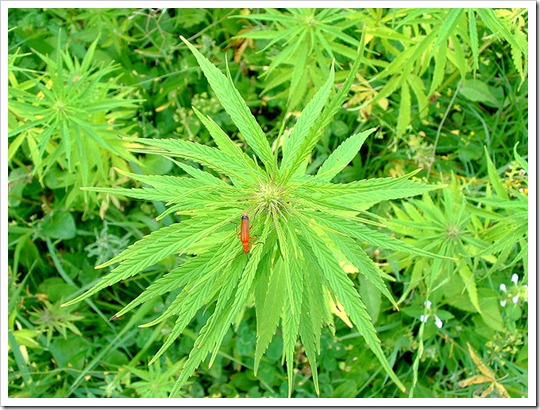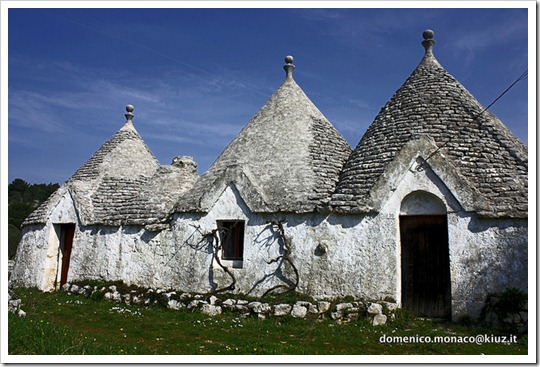Breaking News … Cannabis Can Restore Your Trullo! Posted by Geoff on Oct 13, 2014 in News, Vocabulary
I can never hear the word cannabis without being transported back to my hippy days in the mid 70’s.
My friend’s father used to keep budgerigars, and in those days bird feed contained fertile cannabis seeds. I think it was during the extraordinarily hot summer of 75 that a strange leafy plant of gigantic proportions appeared at the end of his garden, in the very spot where he deposited the budgie waste. Despite our general botanical ignorance, our adolescent eyes quickly identified the alien invader as a very healthy member of the cannabis family.
Much to my friend’s fathers surprise, the unusual plant disappeared one mid-summer’s night. That was around the time that he began to notice a strange dreamy look on the faces of his son’s long haired mates, accompanied by sudden fits of giggling about nothing in particular. Now, I wonder what became of that plant?
 |
| … what on earth is that growing at the bottom of the garden? Photo (CC) OliBac |
A Potted History Of Cannabis Cultivation In Italy (pardon the pun!)
Here we are, decades later, and I ask myself what I would have thought back then if I had know that la canapa (cannabis) had long been an important legal crop here in Italy. However, it wasn’t for its psychedelic qualities that it was grown, but its tough fibrous stalks and stems which lend themselves to producing the high quality rope which was much in demand by the fleets of the Repubbliche marinare, strong sacking like fabrics, and even fine cloths for dressmaking. To give you an idea of just how important cannabis was in Italy: in 1910, 45,000 hectares (one hectare = 1,000 square meters) of land were used for its cultivation in Emilia Romagna alone.
The mass cultivation of canapa eventually went into decline due to an increased use of hessian, cotton, and finally synthetic fibres. When cultivation of the notorious cannabis indica was banned in 1975 due to its popular use as a recreational drug, the hemp industry more or less died out.
Now, however, with growing concerns about the abuse of the natural environment and the overuse of synthetic chemical products, some innovators are taking a fresh look at traditional eco-friendly materials such as hemp. Here’s an excerpt from an interesting article in the online newspaper BRINDISI REPORT discussing the use of hemp in building restoration work.
 |
| A group of trulli near Cisternino. Photo (CC) by Domenico / Kiuz |
What Is A Trullo? Find Out By Clicking Here
CISTERNINO – Ecco uno dei casi pratici di impiego della canapa nel settore dell’edilizia. La tradizione si mescola all’innovazione, con un metodo che garantisce solo vantaggi in un’ottica di rispetto dell’ambiente: è in corso in questi giorni la ristrutturazione con calce e canapa, con materiali quindi interamente “bio”, di un antico gruppo di trulli che si trova tra Cisternino (Brindisi) e Locorotondo (Bari), nel cuore della Valle d’Itria.
CISTERNINO – Here’s a practical example of the use of hemp in the building sector. Tradition and innovation come together in a method that guarantees nothing but advantages in terms of environmental care: the restoration of an old group of trulli between Cisternino (Brindisi) and Locorotondo (Bari), in the heart of the Valle d’Itria, is currently being undertaken employing a completely eco-friendly mix of lime and cannabis.
“I vantaggi sono immensi – spiega Andrea Carletti, referente regionale di AssoCanapa in Puglia – perché si risolve il problema dell’umidità, impiegando un prodotto del tutto naturale. La canapa viene coltivata, raccolta, lavorata. Si procede alla separazione della fibra dal canapulo, poi viene portata sul cantiere. Per le applicazioni si usano solo quattro elementi, calce idrata, canapulo, acqua e un mix di minerali per legare la calce con la canapa”.
“The advantages are huge – explains Andrea Carletti, local representative of AssoCanapa in Puglia – because the problem of humidity can be resolved through the use of a completely natural product. The hemp is cultivated, harvested and worked. Then the separation of the fibres is carried out, and it’s transported to the work site. Only four elements are used in its application: hydrated lime, hemp, water, and a mixture of minerals to bind the lime with the hemp”.
Have you ever been to Puglia? I’d love to see the Trulli.

Build vocabulary, practice pronunciation, and more with Transparent Language Online. Available anytime, anywhere, on any device.




Comments:
Joan Engelhaupt:
It was because I was going to Puglia (town of Ostuni)eight years ago with Global Volunteers to teach English in an Italian high school that I first started trying to learn Italian. I thought I wouldn’t continue once I got back to the U.S., but I found I loved the language and am still trying to learn it. I saw the remarkable trulli and many other wonderful things.
Allan Mahnke:
Hilarious and informative in one go!
Bravo!
Mamma:
Hemp is now being grown again in East Anglia (G.B.) When it was first proposed the media was at great pains to stress that it had no association with the drug cannabis and that it would be futile to plunder the fields!!!
Geoff:
@Mamma I bet you were disappointed weren’t you Mother! 😉